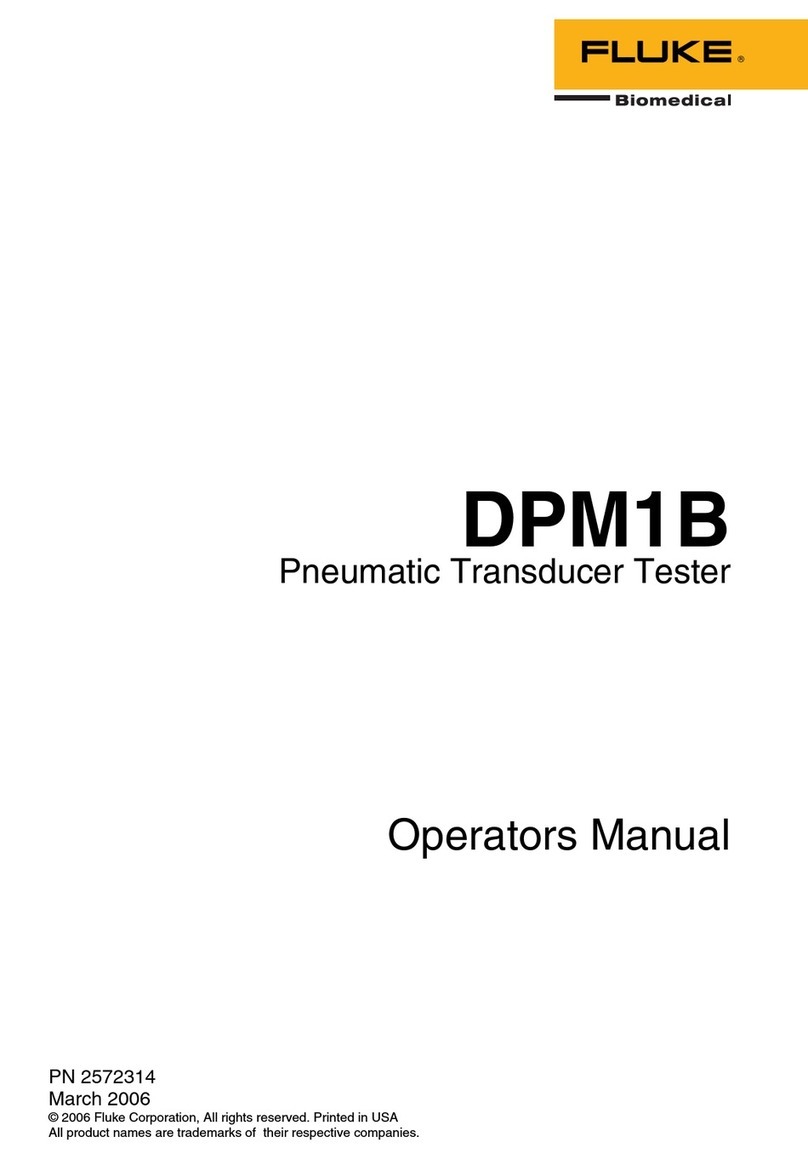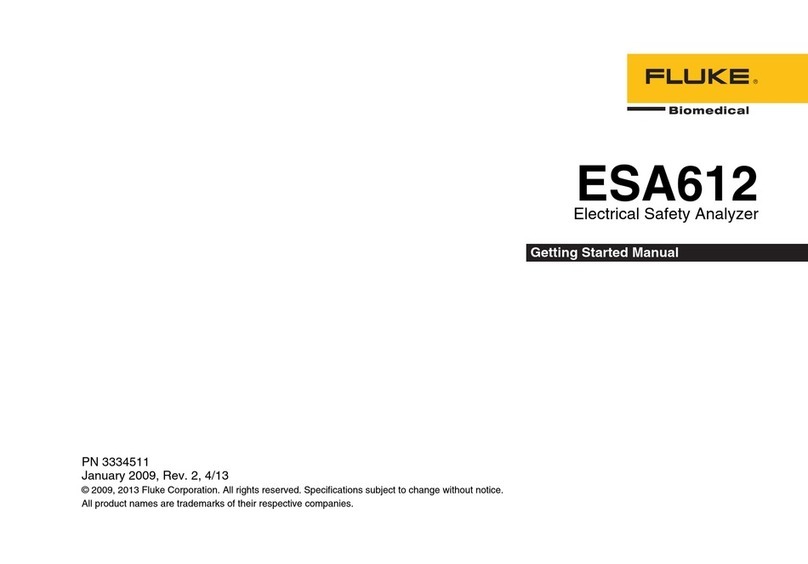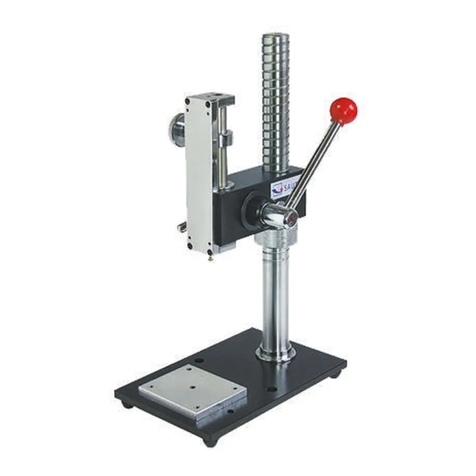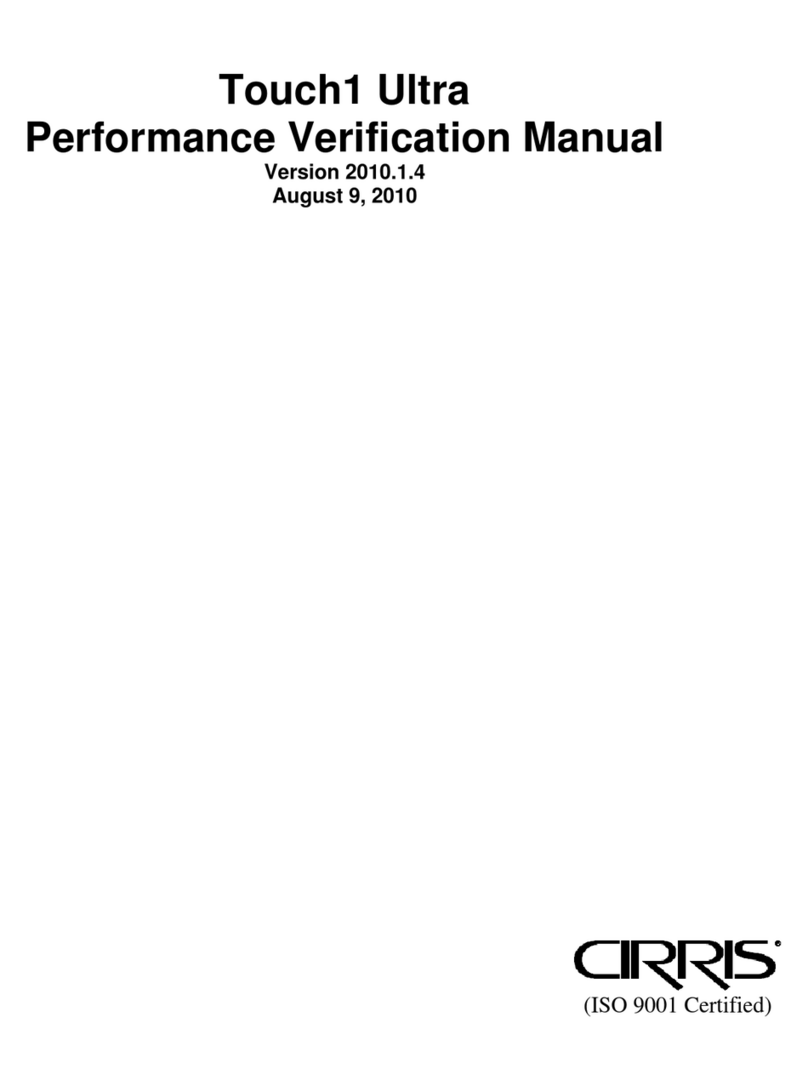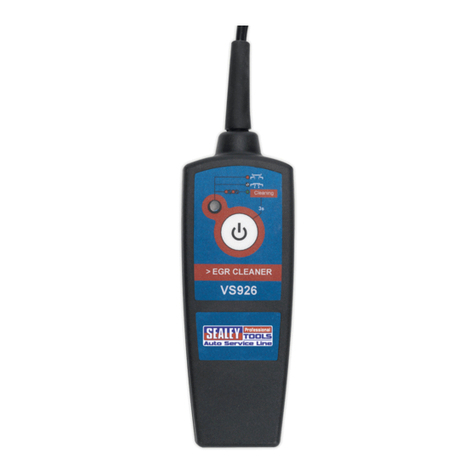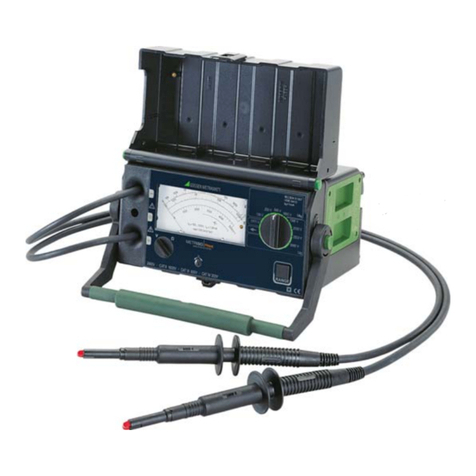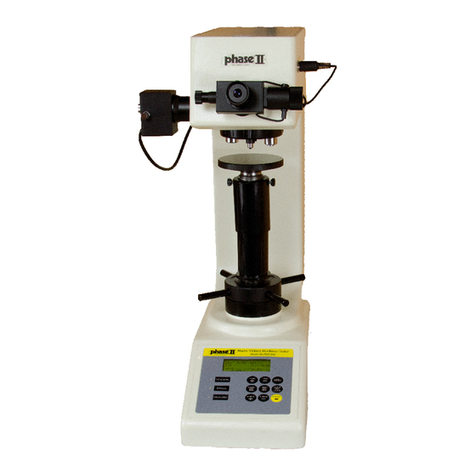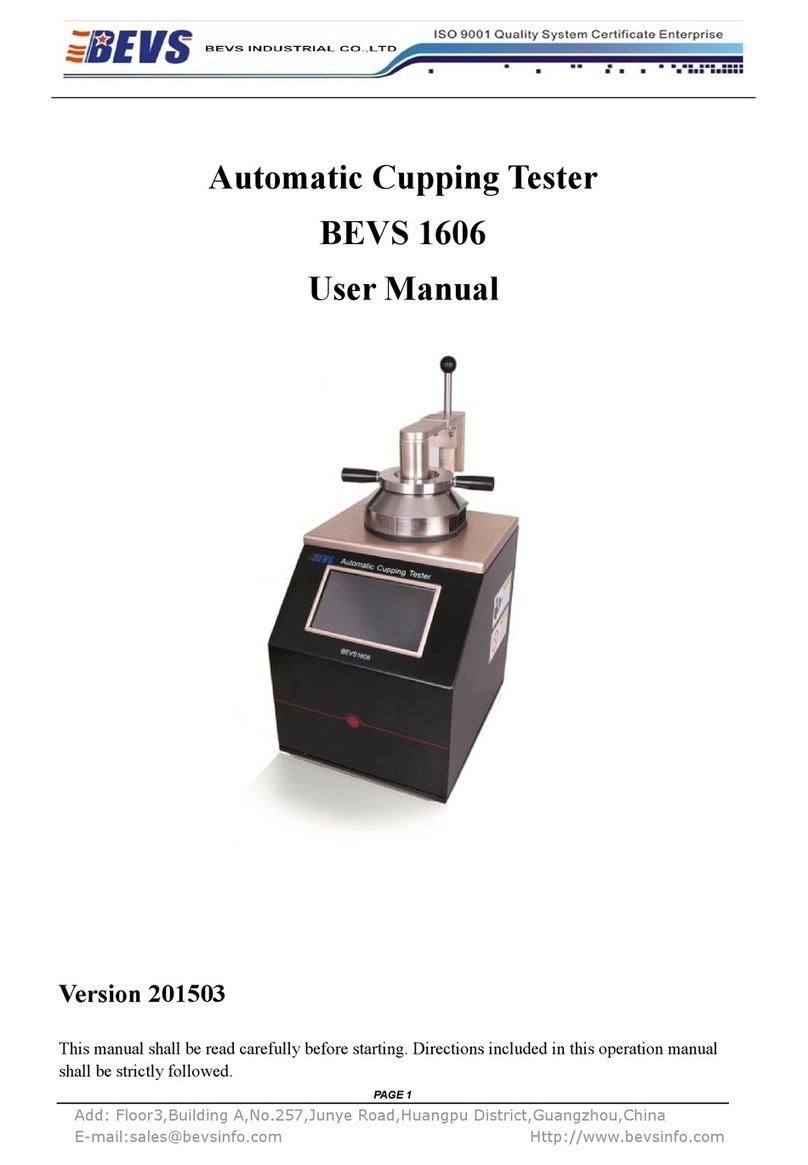Fluke Biomedical DPM1B User manual

PN 2572314
March 2006, Rev. 1, 4/15
© 2006-2015 Fluke Corporation. All rights reserved. Specifications are subject
to change without notice. All product names are trademarks of their respective
companies.
DPM1B
Pneumatic Transducer Tester
Operators Manual

Warranty and Product Support
Fluke Biomedical warrants this instrument against defects in materials and
workmanship for one full year from the date of original purchase. During the
warranty period, we will repair or, at our option, replace at no charge a product
that proves to be defective, provided you return the product, shipping prepaid,
to Fluke Biomedical. This warranty does not apply if the product has been
damaged by accident or misuse or as the result of service or modification by
other than Fluke Biomedical. IN NO EVENT SHALL FLUKE BIOMEDICAL BE
LIABLE FOR CONSEQUENTIAL DAMAGES.
Only serialized products and their accessory items (those products and items
bearing a distinct serial number tag) are covered under this one–year warranty.
PHYSICAL DAMAGE CAUSED BY MISUSE OR PHYSICAL ABUSE IS NOT
COVERED UNDER THE WARRANTY. Items such as cables and nonserialized
modules are not covered under this warranty.
Recalibration of instruments is not covered under the warranty.
This warranty gives you specific legal rights, and you may also have other
rights which vary from state to state, province to province, or country to country.
This warranty is limited to repairing the instrument to Fluke Biomedical’s
specifications.
Warranty Disclaimer
Should you elect to have your instrument serviced and/or calibrated by
someone other than Fluke Biomedical, please be advised that the original
warranty covering your product becomes void when the tamper-resistant
Quality Seal is removed or broken without proper factory authorization. We
strongly recommend, therefore, that you send your instrument to Fluke
Biomedical for factory service and calibration, especially during the original
warranty period.

Notices
All Rights Reserved
Copyright 2006-2015, Fluke Biomedical. No part of this publication may be
reproduced, transmitted, transcribed, stored in a retrieval system, or translated into any
language without the written permission of Fluke Biomedical.
Copyright Release
Fluke Biomedical agrees to a limited copyright release that allows you to reproduce
manuals and other printed materials for use in service training programs and other
technical publications. If you would like other reproductions or distributions, submit a
written request to Fluke Biomedical.
Unpacking and Inspection
Follow standard receiving practices upon receipt of the instrument. Check the shipping
carton for damage. If damage is found, stop unpacking the instrument. Notify the carrier
and ask for an agent to be present while the instrument is unpacked. There are no
special unpacking instructions, but be careful not to damage the instrument when
unpacking it. Inspect the instrument for physical damage such as bent or broken parts,
dents, or scratches.
Technical Support
For application support or answers to technical questions, either email
techservices@flukebiomedical.com or call 1-800- 850-4608 or 1-440-248-9300. In
Claims
Our routine method of shipment is via common carrier, FOB origin. Upon delivery, if
physical damage is found, retain all packing materials in their original condition and
contact the carrier immediately to file a claim. If the instrument is delivered in good
physical condition but does not operate within specifications, or if there are any other
problems not caused by shipping damage, please contact Fluke Biomedical or your
local sales representative.
Returns and Repairs
Return Procedure
All items being returned (including all warranty-claim shipments) must be sent freight-
prepaid to our factory location. When you return an instrument to Fluke Biomedical, we
recommend using United Parcel Service, Federal Express, or Air Parcel Post. We also
recommend that you insure your shipment for its actual replacement cost.
Fluke Biomedical will not be responsible for lost shipments or instruments that are
received in damaged condition due to improper packaging or handling.

Use the original carton and packaging material for shipment. If they are not available,
we recommend the following guide for repackaging:
Use a double–walled carton of sufficient strength for the weight being
shipped.
Use heavy paper or cardboard to protect all instrument surfaces. Use
nonabrasive material around all projecting parts.
Use at least four inches of tightly packed, industry-approved, shock-
absorbent material around the instrument.
Returns for partial refund/credit:
Every product returned for refund/credit must be accompanied by a Return Material
Authorization (RMA) number, obtained from our Order Entry Group at
1-440-498-2560.
Repair and calibration:
To find the nearest service center, go to www.flukebiomedical.com/service or
In the U.S.A.:
Cleveland Calibration Lab
Tel: 1-800-850-4608 x2564
Email:
Everett Calibration Lab
Tel: 1-888-99 FLUKE
(1-888-993-5853)
In Europe, Middle East, and Africa:
Eindhoven Calibration Lab
Tel: +31-40-2675300
In Asia:
Everett Calibration Lab
Tel: +425-446-6945
Email:
To ensure the accuracy of the Product is maintained at a high level,
Fluke Biomedical recommends the product be calibrated at least once every
12 months. Calibration must be done by qualified personnel. Contact your local
Fluke Biomedical representative for calibration.
Certification
This instrument was thoroughly tested and inspected. It was found to meet
Fluke Biomedical’s manufacturing specifications when it was shipped from the factory.
Calibration measurements are traceable to the National Institute of Standards and
Technology (NIST). Devices for which there are no NIST calibration standards are
measured against in-house performance standards using accepted test procedures.
WARNING
Unauthorized user modifications or application beyond the published specifications may
result in electrical shock hazards or improper operation. Fluke Biomedical will not be
responsible for any injuries sustained due to unauthorized equipment modifications.
Restrictions and Liabilities
Information in this document is subject to change and does not represent a
commitment by Fluke Biomedical. Changes made to the information in this
document will be incorporated in new editions of the publication. No responsibility
is assumed by Fluke Biomedical for the use or reliability of software or equipment
that is not supplied by Fluke Biomedical, or by its affiliated dealers.
Manufacturing Location
The DPM1B Pneumatic Transducer Tester is manufactured at Fluke Biomedical,
6920 Seaway Blvd., Everett, WA, U.S.A.

i
Table of Contents
Title Page
Introduction........................................................................ 1
Safety ............................................................................. 1
Symbols.......................................................................... 3
Manual Objectives.......................................................... 3
Summary of Features..................................................... 3
Applications .................................................................... 4
Testing Capabilities ........................................................ 4
Specifications .................................................................... 5
Tester Familiarization ........................................................ 6
Front Panel..................................................................... 6
Back Panel ..................................................................... 7
Accessories ....................................................................... 7
Operation Overview........................................................... 8
Operating the DPM1B .................................................... 8
Setup .............................................................................. 8
Zeroing the Monitor and Tester...................................... 9
Pressure Measurement.................................................. 10
Testing Transducer Linearity............................................. 11
Transducer Sensitivity Test ............................................... 12
Testing Other Devices ....................................................... 13
Multiplication Factors......................................................... 13
Maintenance ...................................................................... 14
Cleaning Outside Surfaces ............................................ 14
Battery Replacement...................................................... 14

DPM1B
Operators Manual
ii

iii
List of Tables
Table Title Page
1. Symbols............................................................................. 3
2. Accessories ....................................................................... 7
3. Multiplication Factors......................................................... 13

DPM1B
Operators Manual
iv

v
List of Figures
Figure Title Page
1. DPM1B Front Panel........................................................... 7
2. DPM1B to Monitor Setup................................................... 9
3. DPM1B Vented to Atmosphere ......................................... 10
4. DPM1B Configured to Apply Pressure to Transducer....... 11
5. Sample Plot of Transducer Linearity Using the DPM1B ... 12

DPM1B
Operators Manual
vi

1
Introduction
This document is the Operators manual for the DPM1B Pneumatic
Transducer Tester (hereafter “the Tester”). It contains general
information about the Tester, a description of its components and
instructions or documentation required to service the unit. If a problem
develops, the user should contact Fluke Biomedical.
Caution
The user should never attempt to service the unit before
consulting with Fluke Biomedical service personnel.
Safety
The Tester draws only 7 mA of current during operation; however, it is
often connected to electrical equipment. Follow the manufacturer’s
electrical safety guidelines for equipment attached to the Tester.
A Warning identifies conditions and procedures that are dangerous to
the user. A Caution identifies conditions and procedures that can
cause damage to the Product or the equipment under test.
Warning
To prevent possible electrical shock, fire, or personal
injury:
• Use the Product only as specified, or the
protection supplied by the Product can be
compromised.
• Read all safety information before you use the
Product.
• Carefully read all instructions.
• Remove the battery if the Product is not used for
an extended period of time, or if stored in
temperatures above 50 °C. If the battery is not
removed, battery leakage can damage the
Product.

DPM1B
Operators Manual
2
• The battery door must be closed and locked
before you operate the Product.
• Replace the battery when the low battery indicator
shows to prevent incorrect measurements.
• Use the correct terminals, function, and range for
measurements.
• Do not use the Product around explosive gas,
vapor, or in damp or wet environments.
• Do not use the Product if it operates incorrectly.
• Examine the case before you use the Product.
Look for cracks or missing plastic. Carefully look
at the insulation around the terminals.
• Use this Product indoors only.
• Remove all probes, test leads, and accessories
before the battery door is opened.
• Remove all probes, test leads, and accessories
that are not necessary for the measurement.
• Disable the Product if it is damaged.
• Do not use the Product if it is damaged.
Caution
To avoid possible damage to the Tester:
•Do not connect Tester to a sterile environment unless
a new sterile filter is used.
•Do not allow any liquid into the pressure port of the
transducer. Use the provided filter between the Tester
and liquid.

Pneumatic Transducer Tester
Introduction
3
Symbols
Table 1 is a list of symbols found in this manual or on the Tester.
Table 1. Symbols
Symbol Description
Risk of Danger. Important information. See Manual.
Conforms to European Union directives
Conforms to relevant Australian EMC standards
Battery
This product complies with the WEEE Directive (2002/96/EC)
marking requirements. The affixed label indicates that you
must not discard this electrical/electronic product in domestic
household waste. Product Category: With reference to the
equipment types in the WEEE Directive Annex I, this product is
classed as category 9 "Monitoring and Control Instrumentation"
product. Do not dispose of this product as unsorted municipal
waste. Go to Fluke’s website for recycling information.
Manual Objectives
•Information about the design of the Tester to enable the user to
understand its use.
•Detailed guidance for maintaining and storing the unit.
•Procedures for setting up and operating the Tester.
Summary of Features
The Tester is a hand-held pressure measuring device, designed as an
aid in the performance testing and troubleshooting of pneumatic or
hydraulic systems. A liquid crystal display (LCD) reading indicates
pressures manually generated from an internal chamber.
Testing blood pressure transducers is easy: Simply connect a BP
transducer to the luer lock fitting on the Tester and create any series of
pressures between ±300 mmHg. Pressures can then be compared
directly between the Tester and the manometer or monitors under test.

DPM1B
Operators Manual
4
The Tester has the following features:
•Easy-to-read liquid crystal display (LCD)
•Capable of measuring and generating positive and negative
pressures
•Lightweight and portable
•Operates with air or liquid
•An easily accessible knob for zeroing the unit
•LO BAT displayed on the LCD when the battery is low. The
battery can be accessed and replaced externally
Applications
Many hospital and laboratory instruments measure pressure for
diagnostic purposes. Mercury and water manometers,
sphygmomanometers, and blood pressure monitors are some of these
devices. Maintenance and calibration of these instruments requires a
device capable of both generating and measuring pressure. The Tester
was designed to fit this requirement, particularly in the area of blood
pressure transducers.
The Tester was designed to improve and simplify the measurements
necessary for determining the accuracy of any direct blood pressure
monitoring system. Vacuum (negative) and positive pressures
from −300 mmHg to +300 mmHg can be generated within the Tester
and applied to a system under test. The pressure delivered by the
pneumatic transducer tester is indicated on a liquid crystal display for
quick comparison to the monitor.
The accuracy of mercury or water manometers can be verified with the
Tester. Pressures can be applied simultaneously to the manometer to
be tested and the Tester using a Y-connector. Pressure is applied to
the system as normal, usually with a squeeze bulb. The results can be
compared between the Tester and the manometer under test.
Testing Capabilities
Verifying the proper operation of a blood pressure transducer can be a
tedious and time-consuming task. Usually a mercury or water
manometer is used to generate known values of pressure while the
transducer's response is monitored. A malfunctioning transducer shows
up when comparing the output of the manometer versus the output of

Pneumatic Transducer Tester
Specifications
5
the transducer. Unfortunately, manometers can add significant errors
themselves, because of the difficulty in interpreting the liquid level in the
column. This affects the calibration of and subsequent determination of
the liquid height.
The critical nature of invasive blood pressure measurement requires a
properly calibrated monitoring system capable of linear operation over a
wide range of pressure levels. Pressures at the catheter tip should be
accurately transmitted through the connective tubing and stopcocks to
the transducer-sensing diaphragm. In a properly operating system,
distention of the diaphragm will generate an output voltage proportional
to the applied pressure. Occasionally, one or more of the elements
involved in this process will malfunction causing inaccurate indications
of blood pressure on the monitor. Very often these errors can be
attributed to a transducer with a nonlinear response or shifted
sensitivity.
Specifications
Pressure Measurement Range ............................ ±300 mmHg
Pressure Generation Range ................................ ±300 mmHg
Altitude .................................................................. Up to 2000 m
Humidity ................................................................ 80 % relative humidity up to 31 °C
(88 °F), decreasing linearly to 50 %
relative humidity at 40 °C (104 °F)
IP Rating ................................................................ IEC 60529: IP40
Safety ..................................................................... IEC 61010-1: Pollution Degree 2
Accuracy................................................................ ±1 % of reading or
±1 mmHg (Whichever is greater)
Temperature Performance
Operating ............................................................ 10 °C to 40 °C
50 °F to 104 °F
Storage ............................................................... -20 °C to 60 °C
-4 °F to 140 °F
Overpressure ........................................................ Not to exceed 1000 mmHg
Voltage Requirements.......................................... One 9 V alkaline battery
Battery Life ............................................................ 60 hours continuous use
Display ................................................................... 0.5 in (1.3 cm) LCD with LO BAT
indicator
Dimensions ........................................................... 5.8 in x 3.6 in x 1.5 in
(14.6 cm x 15.9 cm x 3.8 cm)
Weight.................................................................... 10 oz. (260 g)

DPM1B
Operators Manual
6
Electromagnetic Compatibility (EMC)
International ........................................................IEC 61326-1: Portable
CISPR 11: Group 1, Class A
Group 1: Equipment has intentionally generated and/or uses conductively-coupled
radio frequency energy that is necessary for the internal function of the equipment
itself.
Class A: Equipment is suitable for use in all establishments other than domestic
and those directly connected to a low-voltage power supply network that supplies
buildings used for domestic purposes. There may be potential difficulties in
ensuring electromagnetic compatibility in other environments due to conducted and
radiated disturbances.
Emissions that exceed the levels required by CISPR 11 can occur when the
equipment is connected to a test object.
USA (FCC) ..........................................................47 CFR 15 subpart B
Tester Familiarization
The Tester incorporates a highly accurate digital pressure meter and
pneumatic pressure-generating cylinder into a small, hand-held
package for determining the accuracy of most blood pressure
measurement systems.
Front Panel
The Tester incorporates a specially designed pressure cylinder and
precise solid-state transducer for generating and measuring static
pressure from −300 mmHg to +300 mmHg. The following items are
identified in Figure 1:
•ON/OFF Switch: Used to power the Tester.
•Thumbwheel: Used to regulate the pressure and pressure
value displayed on the LCD.
•Luer Lock: Built-in to provide the external connection for
stopcocks or pressure fittings.
•ZERO Knob: Adjusts LCD reading to zero.
•Liquid Crystal Display (LCD): Illuminated when the Tester is -
powered. Displays LO BAT when the battery is low.
Note
When the Tester is first powered ON, the display may take a
few seconds to settle to zero.

Pneumatic Transducer Tester
Accessories
7
ON/OFF Switch
Thumbwheel
LCD
Luer Lock
Connection
Site
ZERO Knob
ehf1.eps
Figure 1. DPM1B Front Panel
Back Panel
The back panel of the Tester houses the storage compartment for the
9 V alkaline battery.
Accessories
Table 2 is a list of accessories available for the Tester.
Table 2. Accessories
Accessory Fluke Part Number
DPM1B Operators Manual 2572314
Acrodisc Filter 2212678
4-way stopcock 2242666

DPM1B
Operators Manual
8
Operation Overview
When operating according to the instructions given in this section, the
Tester produces and displays a pressure for comparison to the
displayed pressure on the monitor the blood pressure transducer under
test is connected to. A conversion table is found in Multiplication
Factors section that quickly provides the multiplication factors to
compare various units of measure.
Operating the DPM1B
Occasionally a blood pressure transducer under test may not have the
sensitivity specified by the manufacturer of the monitor the transducer
under test is connected to. By matching gain adjustments on the
monitor, deviations in sensitivity can usually be compensated for. A
transducer that is not performing as specified, however, could have
other problems, and sensitivity measurements can be an early
indication of performance deterioration.
Setup
1. Connect the Tester transducer, monitor, and 2 stopcocks as
shown in Figure 2.
Note
The stopcock connecting the Tester to the transducer is used
to vent the system to the atmosphere. The other stopcock is
used to fill the transducer dome with liquid.
2. Ensure that the testing medium is homogeneous before
beginning any test. The transducer testing can be
accomplished using either an air or liquid-fill system.
Note
Do not mix air and liquid in any part of the system; inaccurate
readings could result.
Caution
To avoid possible damage to the Tester:
•Do not connect Tester to a sterile environment unless
a new sterile filter is used.
•Do not allow any liquid into the pressure port of the
transducer. Use the provided filter between the Tester
and liquid.

Pneumatic Transducer Tester
Operation Overview
9
Pneumatic
Transducer
Tester
BP Input
Filter
Monitor
2
1
ehf2.eps
Figure 2. DPM1B to Monitor Setup
3. When the system is to be filled with liquid, position Stopcock 1
as shown in Figure 2.
4. Attach a liquid-filled syringe to the top port of Stopcock 2.
5. Position the valve on Stopcock 2 so that the syringe can be used
to fill the system with liquids. (Turn the valve on the stopcock so
that the two opposing end arrows point straight up and down and
the middle arrow points toward the Tester, as depicted in
Figure 2.)
6. After filling the system, position both Stopcocks as shown in
Figure 2.
7. Remove syringe from top part of Stopcock 2.
Proceed to the section labeled Zeroing the Monitor and Tester.
Zeroing the Monitor and Tester
Properly zeroing the measurement system is important to accurately
determine transducer sensitivity.
1. Position the valve on Stopcock 1 as shown in Figure 4.
2. Press the ZERO or BALANCE control on the monitor.
3. Turn the Tester ON using the ON/OFF switch on the front
panel.

DPM1B
Operators Manual
10
Note
Allow approximately 3 minutes warm-up time before taking
readings; this allows the electronics to stabilize in the Tester.
4. Zero the Tester by turning the ZERO knob on the front panel of
the Tester (See Figure 1 for location of ZERO knob).
5. When the monitor has zeroed, reposition the valve of the
stopcock as shown in Figure 3.
Pressure Measurement
1. Position the stopcock as shown in Figure 4.
2. Move the thumbwheel of the Tester to change the static
pressure generated. See Figure 1 for location of thumbwheel.
The thumbwheel is rotated down for positive pressure or up for
vacuum pressures.
3. Observe the LCD.
4. Compare the LCD reading on the Tester to the monitor reading
to determine the accuracy of the measurement system.
Note
If the system appears to be losing pressure, carefully check all
fittings and connections.
DPM-1B
Filter
2
1
Test Transducer
Vent Port
ehf3.eps
Figure 3. DPM1B Vented to Atmosphere
Other manuals for DPM1B
1
Table of contents
Other Fluke Biomedical Test Equipment manuals
Popular Test Equipment manuals by other brands

Tonghui
Tonghui SM6029 user manual

Integrity
Integrity NexPore CF 7.2 instruction manual
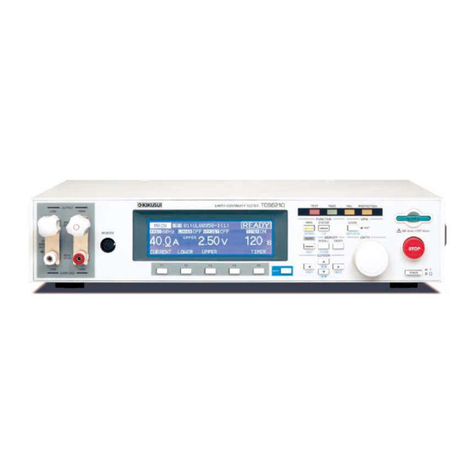
Kikusui
Kikusui tos6200 Operation manual
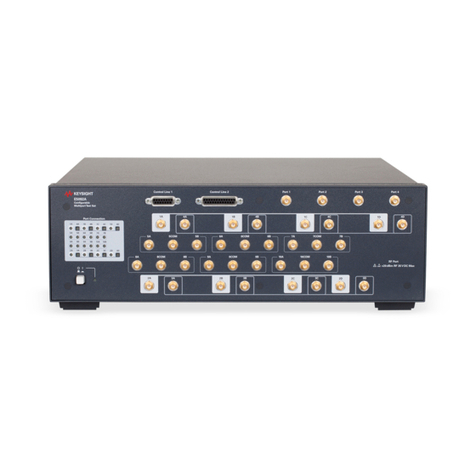
Agilent Technologies
Agilent Technologies ENA Series Service guide
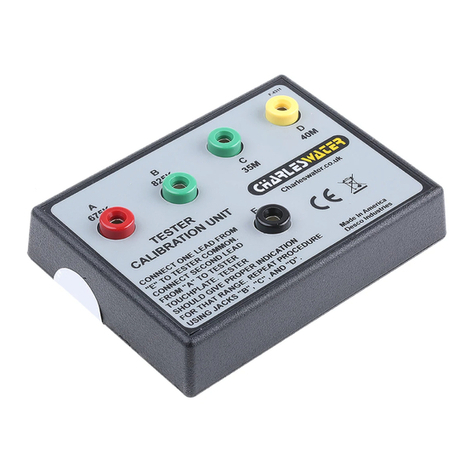
CharlesWater
CharlesWater 99090 Operation and maintenance
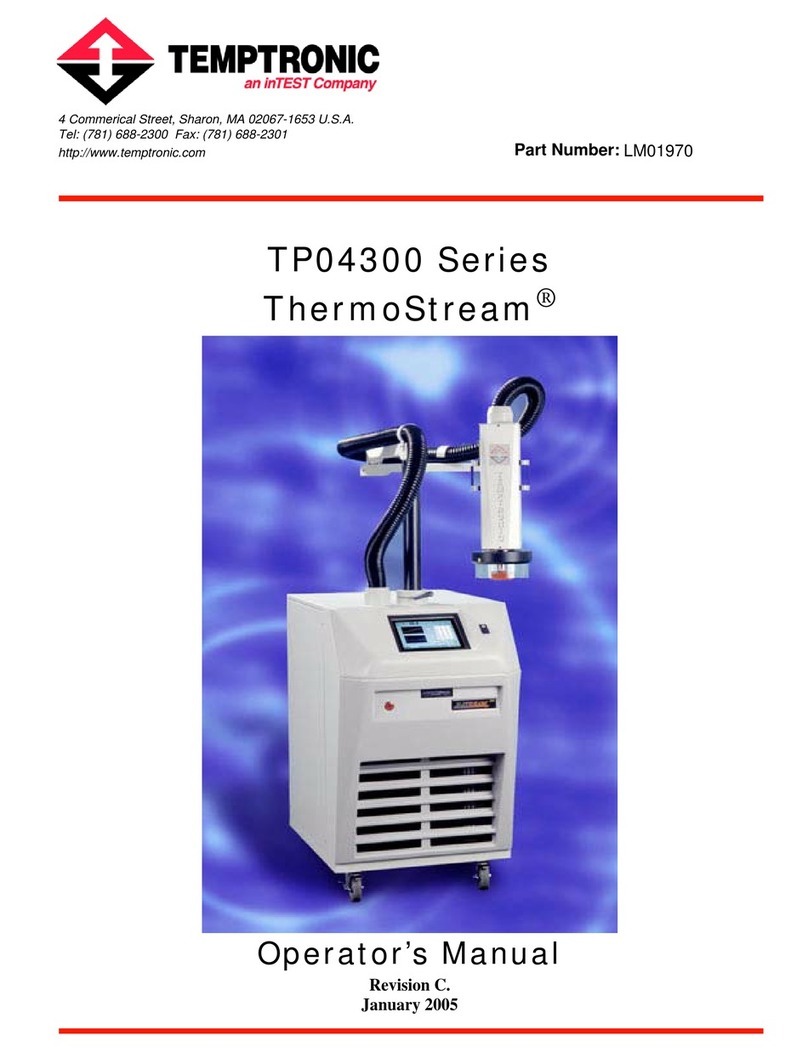
inTest
inTest Temptronic ThermoStream TP04300 Series Operator's manual
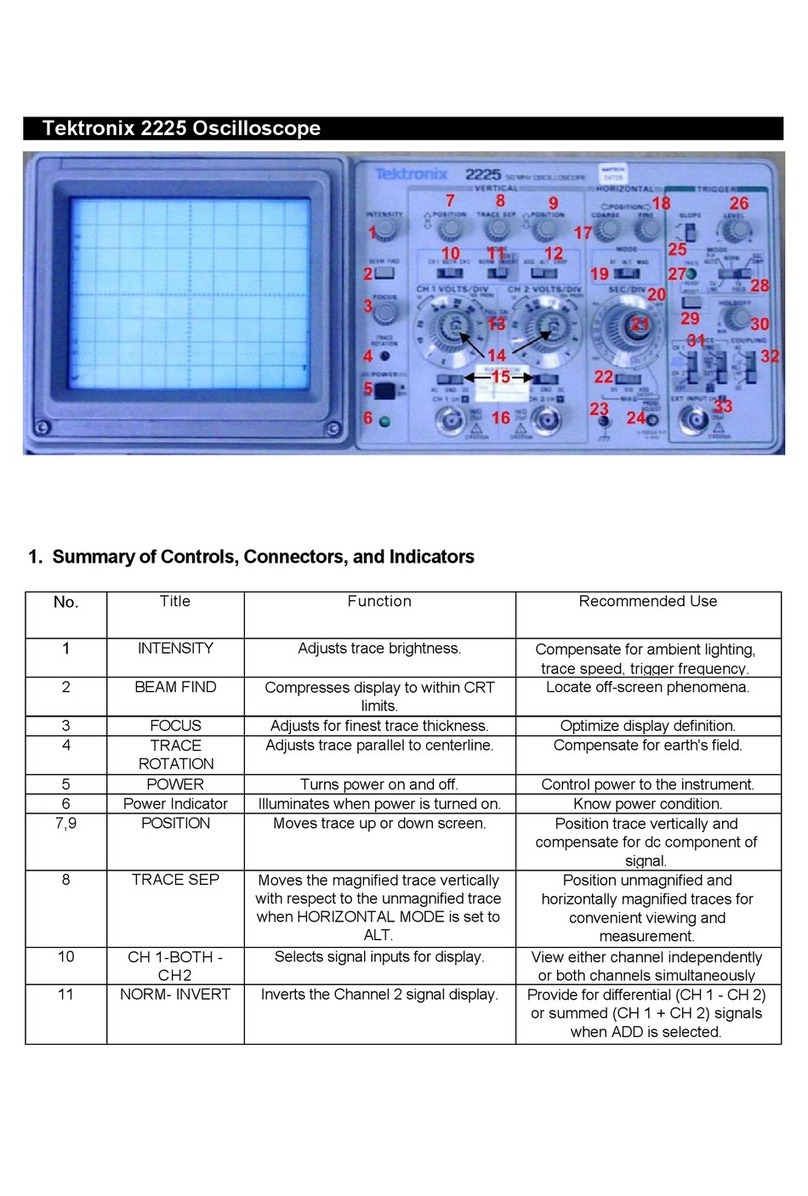
Tektronix
Tektronix 2225 manual
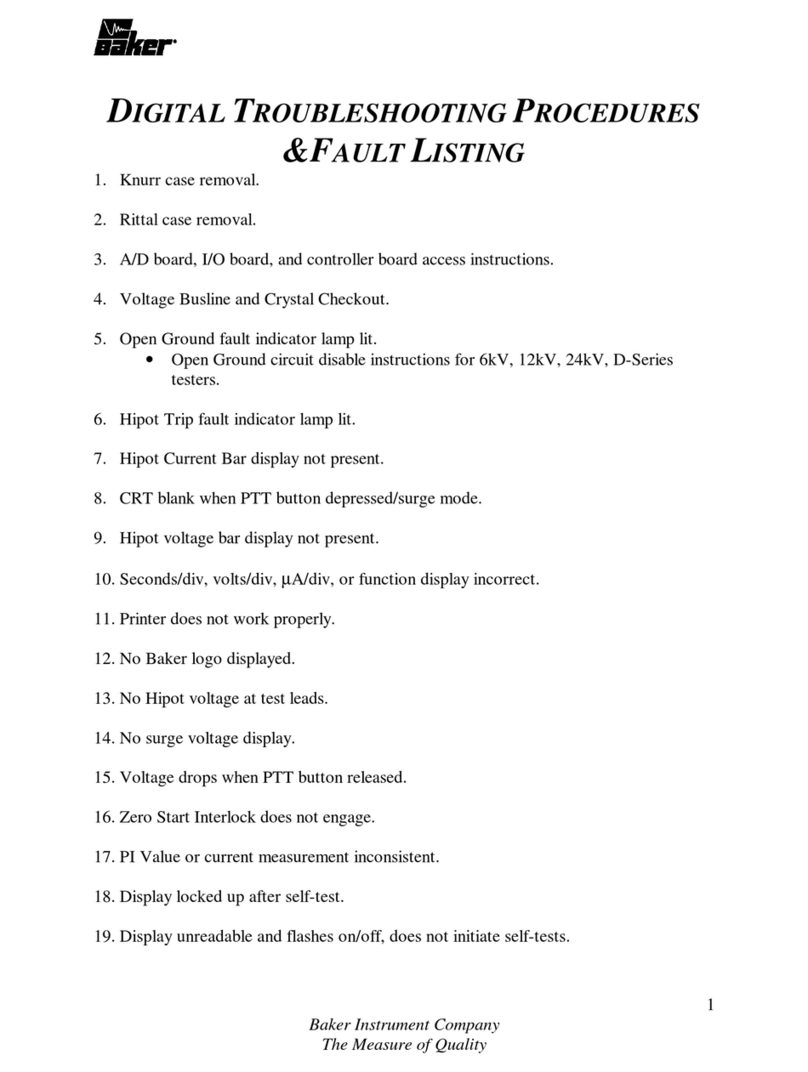
Baker Instrument Company
Baker Instrument Company D6000 DIGITAL TROUBLESHOOTING PROCEDURES & FAULT LISTING
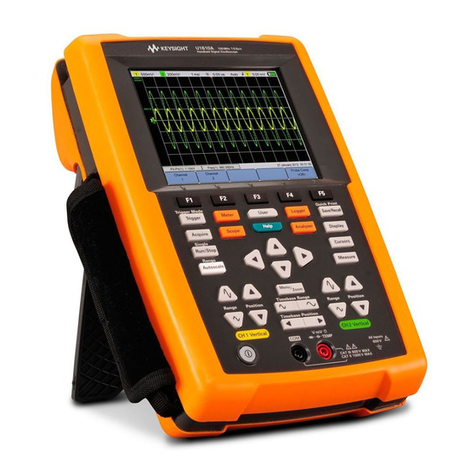
Keysight Technologies
Keysight Technologies U1610/20A Service guide
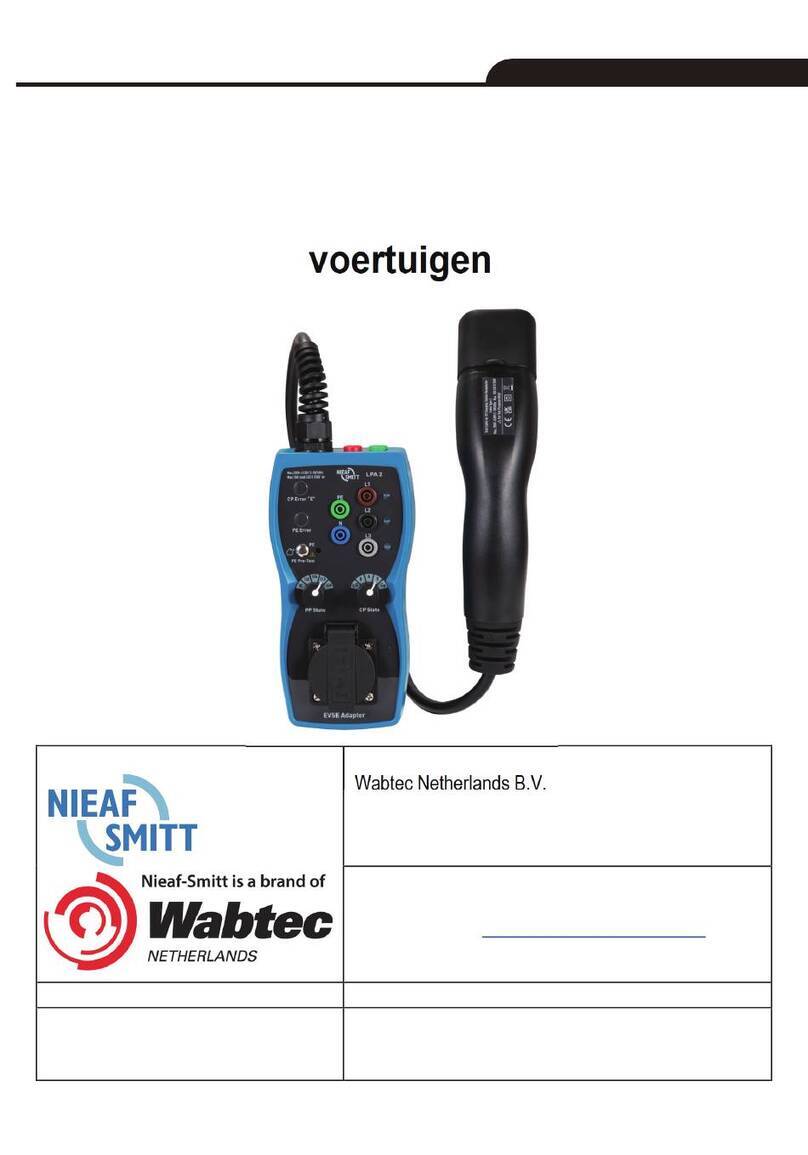
Wabtec
Wabtec NIEAF SMITT LPA 2 Operating instruction
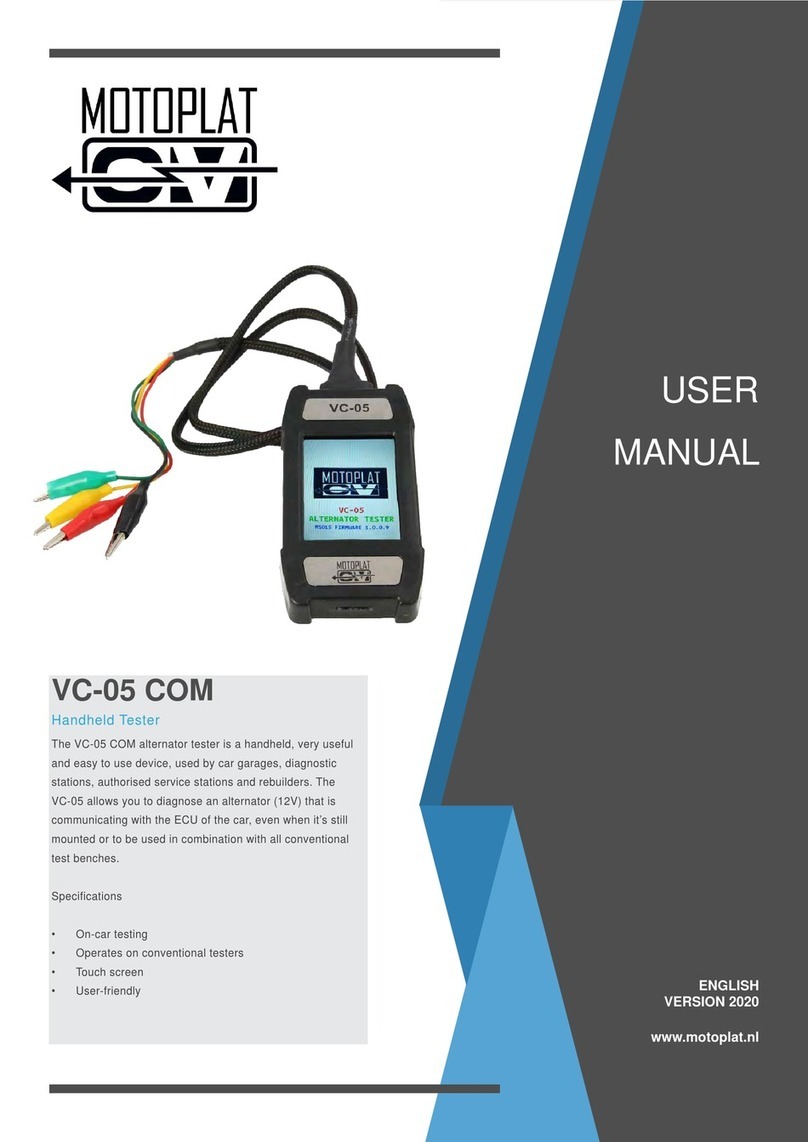
Motoplat
Motoplat VC-05 COM user manual
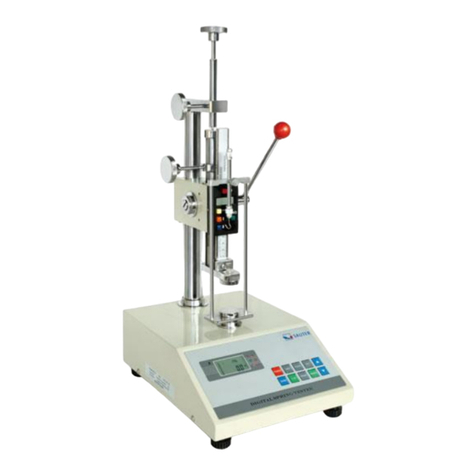
sauter
sauter SD Series instruction manual

